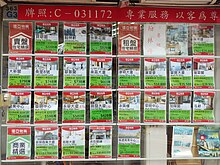Filtering (housing)
In markets with sufficient housing supply, homes will command the highest prices and rents when brand new, and depreciate over time as they get older.
[1] Importantly, filtering depends upon sufficient supply[2] (either from new construction in a growing area, or depopulation — see Housing in Japan).
[3] A 2014 Syracuse University study found that, in the United States, "the nation’s housing stock filters down at a rate of roughly 1.9 percent per year in real terms".
A 2020 study by the National Multifamily Housing Council explained:[2] In decades past it was the substantial flow of new construction, largely targeted to middle- and higher-income groups, that enabled the filtering process to operate.
In the face of its current constriction, well below levels normally associated with employment growth, we gain fresh appreciation for the broader benefits of housing construction.
